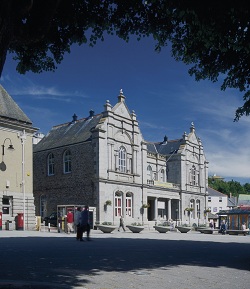A 20-point manifesto may sound a little scary, but Kids in Museums’ 20 ways to make a visit family friendly is anything but. This a practical and, above all, ‘do-able’ guide to making your museum or gallery welcoming, friendly, fun and relevant. There are examples of brilliant practice taking place in museums and galleries all around the country. The Kids in Museums Manifesto simply takes all the best bits and lists them in a down-to-earth and straightforward way, making it easier to make small step-changes in even the most die-hard of organisations.
Falmouth Art Gallery is funded by the local authority and, as such, all services, including admission and school visits, are offered free of charge. Nevertheless, the art gallery is accountable. For example, it received 42,000 visitors in 2012, of which 12% of visits were learning-related; it ran 144 learning sessions with 45 different learning groups, including Primary and Secondary Schools, Home Educated children, young people from the Pupil Referral Centre, adults with learning disabilities, people with dementia, babies, toddlers and a whole range of special interest groups. Outcomes such as these help demonstrate the art gallery’s relevance to its stakeholders.

Falmouth Art Gallery occupies the upper floor of a late Victorian building, adjacent to the Town Council offices and above the public library. As with many public buildings built in the 1890s, the architecture is imposing and austere. The art gallery has overcome this with some simple, bright interventions to make the building more inviting, including ‘footprint’ stickers on the walls, the addition of bright colours and banners, colourful art installations and the creation of a fun and accessible cartoon character called ‘Pablo Banana’ on its signs that help guide people up the stairs, the creation of The Beano cartoonist Nick Brennan.
The art gallery is a welcoming space where families are valued. Everyone is made to feel welcome with a nod, a smile or a friendly ‘hello’. It understands that for some people, a visit to an art gallery could be a daunting experience, especially for those with children. Staff have been trained to be positive towards young people, not to say ‘ssh’, and to do away with the word ‘no’. The gallery is committed to saying ‘please touch’ with hands-on exhibits, including its collection of quirky automata. These are wooden or metal wind-up mechanical models driven by simple cogs or dynamos, that make strange noises or have unexpected moves that raise a smile or a chuckle. The youngest visitors are encouraged to be creative with regular ‘Baby Paint’ sessions in the gallery, not tucked away in a back room, but on big washable mats in the gallery, surrounded by works of art. The gallery recently started creative toddler sessions for early years and pre-school children and their families involving music and making activities, all linked to the current exhibition.
We say ‘families’, but actually, the art gallery is careful not to define what makes up a family. It could be people with young children: it could equally be a group of friends, or adults with their older relatives, any group of people, in fact. The key is to be flexible and to be aware that families come in all shapes and sizes.
The wonderful thing about museums and galleries is their wonderful things. They are treasure houses that create conversations between people, spaces where people can get together and talk. Falmouth Art Gallery is a place of inspiration. It has a superb art collection, for example, old master portraits by John Singer Sargent and Thomas Gainsborough, pre-Raphaelite paintings by John William Waterhouse and John Riley Wilmer, Modernist works by Ben Nicholson and Christopher Wood and original photographs by Eve Arnold and Lee Miller. The collection is dynamic, with new pieces being added when funding allows, or offered through gift or bequest. However, the works of art work hard. The gallery invites ‘guest curators’ into the gallery to select exhibits, sharing its practice with the community, especially on the annual Kids in Museums Takeover Day where children come together to choose pictures for display.
Sometimes, the gallery hangs children’s artwork alongside the art collection. In the recent ‘A childhood with the Surrealists’ exhibition, a selection of children’s work from the Saturday afternoon free drop-in workshops was professionally framed and exhibited alongside works by Max Ernst, Pablo Picasso and Joán Miró. Over the previous weeks and months, the workshops had employed Surrealist art techniques, including collage, frottage and solarisation. Picasso said, “it took me four years to paint like Raphael and a lifetime to paint like a child”; this valuing of young people’s art and expression is an important part of Falmouth Art Gallery’s philosophy.
Making your museum ‘family friendly’ is much more than having a box of toys in the corner, or a trail on a clipboard. It’s about attitude and approach. Being inclusive, positive and welcoming makes work more enjoyable, too. If you approach every day with a smile, then, chances are, others will smile too.
The Kids in Museums Manifesto can be found online.
Back to top




